
 World Cup 2010, which kicks off today, is expected to be the most-watched TV event in history. While football soccer has not historically been a largey followed sport in the U.S. – it does seem like more people want to be part of the global experience this year.
World Cup 2010, which kicks off today, is expected to be the most-watched TV event in history. While football soccer has not historically been a largey followed sport in the U.S. – it does seem like more people want to be part of the global experience this year.
Tomorrow’s USA vs England game will be watched by many. England, a contender to win the tournament, is heavily favored, but the U.S. has history on its side. The last time the two teams played a World Cup match was 1950 in Belo Horizonte, Brazil, when the American team beat the British powerhouse 1-0 [link]!
Below the fold you’ll find K’naan’s popular World Cup Anthem “Wavin’ Flag” and the epic Nike “flashforward” commercial (note: Nike isn’t actually a sponsor of the World Cup but this ad has attracted more World Cup-relaed mentions than Adidas, Coca Cola, Sony and Visa). And for those of you who are just beginning to catch the World Cup fever – here’s an overview of what you need to know. So i ask our global Langar Hall audience – what teams will you be rooting for and how will you celebrate the World Cup?
I came across a new movie, “I Am Singh”, which is about the discrimination Sikhs 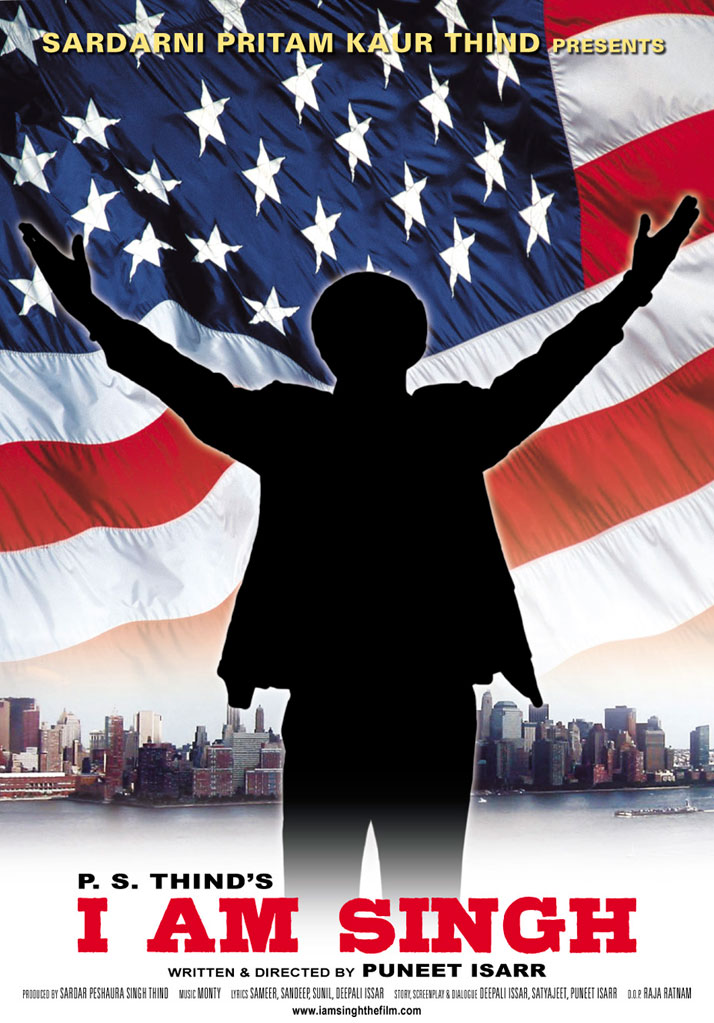 faced post-9/11. Interesting topic indeed.
faced post-9/11. Interesting topic indeed.
It is about time the Sikh experience makes it onto the big screen. I have seen “New York” and “My Name Is Khan”. Both decent bollywood films that highlighted the South Asian Muslim experience in the United States after 9/11. Looking forward to seeing how “I Am Singh” fairs as a feature film-we already have a couple of documentaries on the Sikh experience post 9/11.
The writing has long been on the wall, but the day seems to be drawing closer. Writers and political analysts see the coronation of Kaka Badal (Sukhbir) as soon approaching. It was only last year that Kaka Badal had a position created just for him – Deputy Chief Minister. Insiders in the present government see undertaking underway to begin the transition from his father to himself.
The ground is prepared for smooth transition of succession to the junior Badal. Presently both father and son are out of India to stay with Mrs. Chief Minister-Surinder Kaur Badal-who is suffering from cancer and ade\mitted in a hospital in New York in USA.
Parkash Singh Badal who became the Chief Minister of state fourth time in 2007 is keen to hand over the command of government to his son before the end of his present term. The advisors to the Chief Minister understood to have impressed upon Badal to change the guard by the end of 2010. The next assembly election in Punjab is due in February 2012. The logic is the change will eliminate anti-incumbency factor. [link]
As the once-“Sikh” party now officially becomes nothing more than an instrument of cronyism (granted unofficially this has been the case since at least the 1970s), those that care about Punjab are left to mourn.
Here on young Sikh man cries out asking and pleading what to do for Punjab.

Are there any answers?
Happy Mother’s Day to all the wonderful mother’s who have nourished our physical bodies with food made out of love and nurtured our souls with their warm spirits.
I leave you with one of Satinder Sartaaj’s most beautiful songs, “Ammi”. Among all the many Punjabi songs about mothers, Sartaaj has brought us one of the best. He captures a mother’s spirit and it’s priceless value to not only children but the world.

As we celebrate motherhood today, let’s also remember the value of the girl child. Guru Nanak Ji reminds us in Raaj Aasaa on Pannaa 473:
Vijay “Jay” Chand Gandhi was sworn in as California’s first South Asian federal judge on April 14th. He is only the second Indian American federal judge in the country. Gandhi will be a magistrate judge for the U.S. District Cou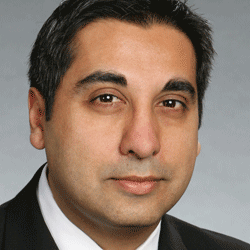 rt in California’s Central District. This district serves Los Angeles, Orange, Riverside, San Bernardino, San Luis Obispo, Santa Barbara and Ventura counties.
rt in California’s Central District. This district serves Los Angeles, Orange, Riverside, San Bernardino, San Luis Obispo, Santa Barbara and Ventura counties.
India-West reports, “The duties of magistrate judges include conducting preliminary proceedings in criminal cases, trying and disposing of misdemeanor cases, ruling on discovery disputes in civil cases, issuing reports in habeas corpus and civil rights cases, trying civil cases and other assigned matters.”
Kiran Jain, president of the South Asian Bar Association in Northern California, told India-West, “As the first South Asian federal judge in California, Judge Gandhi’s appointment is not only an historic advancement in increasing diversity in our judiciary, but a testament to the South Asian American legal community’s progress in advancing our bar to the highest levels of our profession.”
Congratulations Vijay Gandhi! It will be interesting to see if and how Gandhi utilizes his experience as a South Asian American in his work as judge. It is one thing to have a South Asian name and another to actually use your cultural experiences to help the community. I hope he views being a federal judge as an opportunity to shed light on the issues impacting the South Asian community while helping create larger policy changes.
As far as I know, there are no Sikh U.S. federal judges. Do you know of any? If not, I await the day we have Sikh U.S. federal judges. Hopefully it won’t be too much longer. Being a lawyer is one of the top 3 professions many Sikhs pursue any ways.
I have noticed these past couple of weeks that discussions about the value of Punjabi have become more prevalent. The issue of maintaining our “ma boli” is constantly on our minds and manifests in our everyday lives. However, with the onset of many Vaisakhi melas, Nagar Kirtans, and of course Satinder Sartaj concerts the discussions are heightened.
Recently, on Jus Punjabi’s “Aaj Da Mudda” show, there was an insightful conversation about pronunciation and the longevity of Punjabi. The host and guest discussed how East Punjabi’s pronunciation of words have changed (we are taking the easier route). Despite this change in pronunciation, the guest highlighted how Punjabi has survived the most turbulent of times (e.g. the state language during Maharaja Ranjit Singh’s rule was Farsi and the 1960’s division of India Punjab).
As he spoke, I was reminded of Gurdas Mann’s song “Punjabiye Zubane” (listen below). This song captures how the strength of the Punjabi language was developed over time. It is this strength that has allowed it to survive. I am left wondering if we 1) have the will and 2) the capacity to nurture and love this language like others have done in the past. Can we help nurture the strength of Punjabi in today’s context? What do you think?

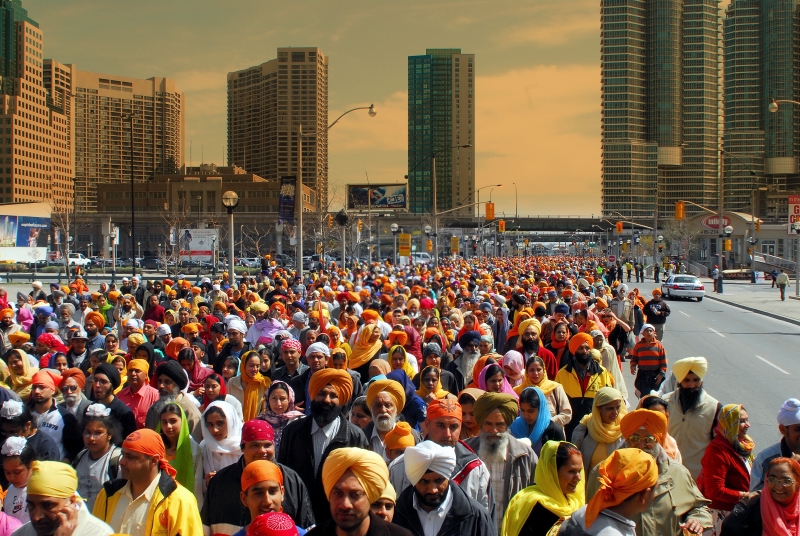 A few weeks back, we attended our first Sikh Parade of the season.
A few weeks back, we attended our first Sikh Parade of the season.
Like every year, we love making the trip downtown to join our sangat and spend a beautiful spring day outside celebrating Vaisakhi. Amongst the sea of kesri dastaars and chunnis, there was keertan, gatka, and jakaaray filling the streets.
As we began marching down the main avenue, I started to notice the passerby’s reaction to us. Some were irritated they had to wait for us to cross the street, some took out their camera phones to take pictures of us, but the vast majority looked, well…confused.
And who can blame them?
None of our floats and few of our signs would make any sense to a non-Sikh. The overlapping keertan, jakaaray, and political slogans were obviously all in Punjabi. And there was little to no interaction between us and the onlookers. I wondered, why did we come here to do this?
If our purpose was to have a nagar keertan and to celebrate Vaisakhi in our own traditional way, then why waste the time and money to do it out here? Why not just do this on our own Gurdwara premises? But if our purpose was to educate the greater community on who Sikhs are, then what exactly were we doing to accomplish that? Sure, many people were taking pictures of us, but was it because of the spectacle we created? Or because people were so happy to see the Sikhs that they’ve heard so much about – followers of Guru Nanak, brave soldiers, and defenders of the downtrodden? Which do you think?
(more…)
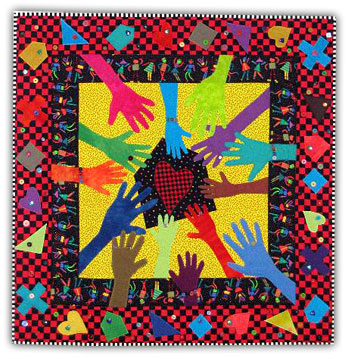 A few years back, I went to my first Charni Lagna ceremony. Charni Lagna – literally, “at the feet of the Guru” is the traditional name of the event where a Sikh formally begins reading from the Guru Granth Sahib.
A few years back, I went to my first Charni Lagna ceremony. Charni Lagna – literally, “at the feet of the Guru” is the traditional name of the event where a Sikh formally begins reading from the Guru Granth Sahib.
Like most Sikh ceremonies, it is actually quite simple. After shabad kirtan is recited, an ardaas is offered for the young (or old) Sikh who is beginning their journey with the Guru – then finally, he or she will read the hukamnama.
The ceremony I attended was for an 11-year old girl, who was very excited and worked hard to prepare for this day. After a few shabads were sung by the local jatha and the girl’s friends – one by one, members of the sangat came to say a few words of encouragement. One of her friends was around the same age and similarly went through this ceremony a year prior. She spoke about her own experience reading from the Guru Granth Sahib on a daily basis and how it has changed her life. Then one of her friends who had yet to take this step spoke of how she was inspired to do so soon. Then came her Punjabi school teacher, then her camp counselors, then other leaders of the community. I noted that neither her parents nor any of her relatives spoke – but instead, they just sat and listened to the members of the sangat, who individually shared such beautiful words of encouragement and praise for this young Kaur, who humbly sat at the feet of the Guru…It was quite powerful.
Finally, as the ardaas ended, there was a rare moment of pin-drop silence in the darbar hall. Then this brave 11 year old girl, surrounded by her proud parents and grandparents, read the hukamnama flawlessly…I was moved by the whole event.
Immediately after the hukmanama was completed, something remarkable happened…
Sikhs will be celebrating Vaisakhi world wide next week on April 14th. Sikhs in Malayasia are requesting that Vaisakhi be made a national holiday.
Tan Sri Darshan Singh, the President of Malaysia National Sikhs Movement president, said, “The Sikhs who arrived earlier in this country served in the security forces and have contributed towards the economic development of Malaysia”. Karpal Singh of DAP believes that Vaisakhi should be given consideration as a national holiday because of its considerable significance to Sikhs. However, Malaysian Sikhs have not gotten a positive response from the government.
A common saying is a community knows when its contributions are being viewed as an important part of a “host” country’s fabric of life when the entire nation gets a day off on a day that is significant to that community. In a nutshell, it means you have really “made it”.
I look forward to the day that non-Sikhs will be taking Vaisakhi off in Malaysia and America. We have “made it” in these countries in many ways although we are often treated like “resident aliens”. I wish it wouldn’t take a national holiday to break that mold, but may be it would help?
A true Sikh hero, Fauja Singh, turned 99 last Thursday.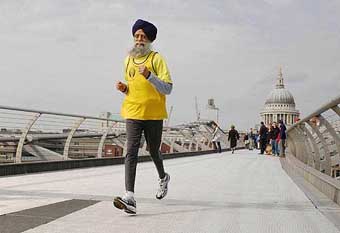
Turbaned Tornado, Fauja Singh turns 99 on Thursday. Here’s wishing this Punjabi icon who manages running marathons at an age not many reach, many happy returns of the day. Besides other gifts that he’d be receiving on his birthday on April 1, this real life ‘Forest Gump’ is all set to give himself a present — by setting yet another marathon record at the ripe age of 99. “I can only sleep, run or walk. I’ll die the day I sit down,” the young nonagenarian had told this scribe in an interview in 2005 on the streets of Ilford, Essex, UK, where he has been living along with his son Sukhjinder Singh since the 1980s. He shifted to UK after having lost his wife and younger son in quick succession in Punjab. [TOI]
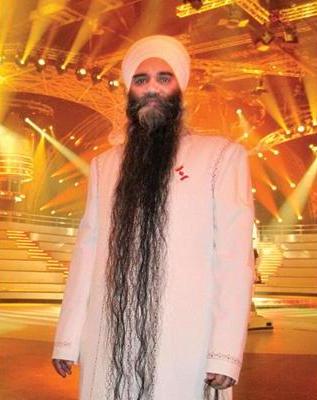 Bhai Sarvan Singh, the head granthi at Guru Nanak Sikh Temple in Vancouver has broken his own Guinness World Record of having the longest beard. His beard is now under 8 feet!
Bhai Sarvan Singh, the head granthi at Guru Nanak Sikh Temple in Vancouver has broken his own Guinness World Record of having the longest beard. His beard is now under 8 feet!
Initially Bhai Sahib was hesitant to take part in the competition because he did not grow his long beard for publicity. He grew it as part of his Sikh faith. However, he soon realized that the publicity actually helped encourage other Sikhs to keep this article of faith.
His translator Avtar Singh Gill said to the Vancouver Sun:
“So many other Sikhs have called him, saying, ‘You’re keeping that long hair and we are cutting our beards; we should not cut them,'” Gill said. “Some of them have promised that. Now he’s more comfortable than at the start.”
I also imagine this publicity is helping educate non-Sikhs about the Sikh faith.
 Arundhati Roy, the author of “God of Small Things”, will be in San Francisco on March 26th at Mission High School Auditorium. The event will start at 7pm.
Arundhati Roy, the author of “God of Small Things”, will be in San Francisco on March 26th at Mission High School Auditorium. The event will start at 7pm.
Tickets can be purchased here.
Roy will be reading from her latest collection of essays, “Field Notes on Democracy: Listening to Grasshoppers”.
This reading is a charity event for the International People’s Tribunal on Human Rights and Justice in Indian-administered Kashmir (IPTK). The proceeds will be used to institute the Peace and Justice Grant For Scholarship and the Arts In Indian-Administered Kashmir for those residing in Indian-administered Kashmir. The grant will be housed at the California Institute of Integral Studies in San Francisco.
Dear Langarites,
Over the next few weeks, we will be presenting posts by several individuals who answered our call for additional bloggers. We hope you welcome their writing and openly dialogue with them. Just this past week, you have seen two of our guest bloggers emerge. As a collective decision, several of these bloggers will join The Langar Hall team – your commentary and feedback will help us determine this next phase of our growth. Please join us in welcoming our guest bloggers!
– The Langar Hall Team
The Saanjh Sikh Scholarship project is awarding 4 scholarships totaling $6,000 to Sikh students who are graduating California high school seniors or community college students pursuing higher education. The scholarship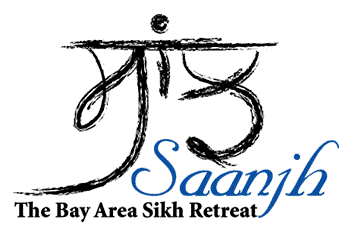 s are need & merit based. All California Sikhs who are graduating high school seniors starting the first year of undergraduate studies at a 4-year university or community college in Fall 2010 can apply for the scholarships. Also, current community college students who will be transferring to a 4-year university in Fall 2010 are eligible to apply for the scholarship. Go-online for more information at www.saanjh.org/scholarship. The deadline is April 01, 2010 April 15, 2010 by 11:59 PST (and no that is not a April fools joke). 🙂
s are need & merit based. All California Sikhs who are graduating high school seniors starting the first year of undergraduate studies at a 4-year university or community college in Fall 2010 can apply for the scholarships. Also, current community college students who will be transferring to a 4-year university in Fall 2010 are eligible to apply for the scholarship. Go-online for more information at www.saanjh.org/scholarship. The deadline is April 01, 2010 April 15, 2010 by 11:59 PST (and no that is not a April fools joke). 🙂
The Saanjh Sikh Scholarships are one of the projects that came out of Saanjh-The Bay Area Sikh Retreat in August 2009. The project’s mission is to work with parents, students, and community members to encourage higher education for California Sikh students by providing need and merit-based scholarships to selected students entering their initial years of undergraduate studies. Awarding the scholarships to enterprising California Sikh students is a good way to support higher education in our community in an effort to create more human and social capital to address the issues impacting the Sikh Quam.
- Join the Saanjh Sikh Scholarship group on Facebook to stay informed!
- Saanjh Sikh Scholarship Sevadars can be contacted at: saanjhscholarship@gmail.com.
- More details about the scholarship and online application can be found at: www.saanjh.org/scholarship.
The four Saanjh Sikh Scholarships are named after contemporary Sikh activists. More information about them and the amount of each scholarship can be found below the fold.
On TLH we have addressed various issues effecting the South Asian elderly community. The recent news article in the the New York Times on the difficulties encountered by many Sikh seniors in the California Bay Area was particularly heart wrenching.
In an article in New America Media, Paul Kleyman discusses the impact of depression on ethnic seniors. Many of his statements of seniors feeling alone and depressed resonated with the stories I have heard about Sikh seniors. I have often heard how Sikh seniors feel like America is a “sweet prison”. You have many material benefits, but also a tremendous amount of social isolation. Even when living with their children and grandchildren, the elderly miss their social life back in Punjab. In the US, the elderly spend the majority of their day separated from their children and grandchildren in time and space. Also, generational gaps coupled with cultural differences create social and emotional distance.
Kleyman writes that ethnic seniors are expected to have similar levels of depression as the white elderly population (about one in six people ages 50 and above), but the main difference is:
“… that African-American, Latino, Asian and Native-American seniors are less apt to get treated. That’s because of their higher levels of poverty, lack of insurance or access to treatment and the pervasive stigma of mental illness in many cultures. Left untreated, depression, anxiety disorder and related conditions can result in debilitating physical ailments, as people eat and sleep more poorly and become less physically active. ”
An interesting infographic circulating the Web has many people talking about the relationship between wealth and religion. The graphic, titled The Almighty Dollar, was created by GOOD and Column Five Media and breaks down income levels in the U.S. by religion. Data is based on information from the Pew Forum and it compares the income level of each religion to the national average. From the website: It’s no secret that the distribution of wealth is inequitable in the United States across racial, regional, and socio-economic groups. But there is a distinct variance among and within America’s faiths as well.
If you click on the image above, it will enlarge and you’ll see information broken down by several religious groups such as Jewish, Christian (divided into several groups), Buddhist, Mormon, Muslim etc. You’ll notice that Sikhism is not one of them (not sure why?). There are five income brackets (Less than $30,000 to $100,000+) listed and numbers signifying what percentage of each religious group falling into which income bracket.
A while back I remember someone posing the question, “Can you be a good person without being part of a religion?” What an excellent question! While recently talking to a government official about allowing Sikhs to work in his agency with our Sikh articles of faith, he told me that he always felt judged by people of faith for not self-indentifying with a religion. What an interesting situation!
Now, I am neither a theological expert nor a saint-I would identify as a Sikh who is a “work in-progress with many moments of procrastination”. However, in both situations, the bottom-line for me is the power of Waheguru. Of course, a person can be “good” without being part of a religion. However, in my opinion, the difference between being an atheist and a good person vs. aspiring to be a good person and being a Sikh is that as Sikhs, we should attribute our goodness to something higher and more powerful than us-Waheguru. An atheist can attribute his/her goodness to himself/herself, which from my perspective can become a very selfish act that feeds ego.
My response to the government official was that the aim of a Sikh is not to judge the level of “goodness” in any person, but to focus on identifying his/her good characteristics. For Sikhs, those good characteristics are the sources of Waheguru’s existence in each person. However, our existence in this world often feeds our ego, lust, greed, attachment, and anger which prevents us from seeing the good in others. Thus, the goal of Sikhs is not to judge someone else, but to be in control of these five vices so we can see the “good” in others and identify with Waheguru. And, taan-tah-dah, he should allow Sikhs to work in his agency with our articles of faith because we would not judge him. 🙂 (Of course, I did not say that to him.)
While thinking about these experiences, I started to realize how as Sikhs we have become very judgmental and selfish. Is it because we are more likely to have a stronger political and cultural affiliation with Sikhi than a spiritual one? Then how can we identify as Sikhs when the fundamental premise of Sikhi is how we relate with each other?
We know there is a sizable Sikh population in Pakistan, despite many Sikhs who were forced to migrate to India during partition. In 2008, the Pakistani Sikh Anand Marriage Act was passed in Pakistani, which allowed Sikhs in their marriage certificates as Sikhs. Currently in India, Sikhs are identified as Hindus in marriage certificates.
Interestingly, I came across this music video by Jassi Singh Lailpura (i.e. Jasbir Singh) , a Pakistani Sikh.
He also gave an interview on a morning Pakistani television show where he talked more abut his music and life. Lailpura believes that a Pakistani is not defined by a religion or race, but by someone who believes it to be their country. It is obvious from the interview that he is a proud Punjabi Sikh from Pakistan. He talks about the impact of Partition on a Sikh woman. You can watch his interview below.

Amarjit Kaur, 39, was critically shot on Wednesday afternoon in Vallejo, California as she sold ice cream out of an ice cream truck near a school. The Bay Area television news reported last night that police believe the reason for the shooting was two fold. First it was a robbery by a 15-year male. Secondly, Kaur’s inability to understand that the English-speaking 15-year old was asking for money caused him to shoot her out of frustration and anger.
As a widowed mother of three and a recent immigrant to the United States, Kaur’s case highlights the struggle that immigrant woman go through to support their families. Her strength to sell ice cream out of a truck while not completely understanding English shows perseverance during adversity but also highlights the risk new immigrants take to build lives for themselves and their families in the United States.
You would imagine that selling ice cream to primarily children would not be high risk. However, Harish Joshi reported that he was held-up twice while operating an ice cream truck in Richmond (California Bay Area).
Kuldeep Malhan, Kaur’s brother-in-law said a fund has been set-up to help support the family at Bank of America, account No. 488019845001. Please donate to help with Kaur’s medical bills and other living expenses while she is unable to work because of her injuries.
Two years ago, a group of friends started this blog to create a platform where we could discuss issues concerning the  Sikh community, in a reflective, self-critical, and progressive way. We envisioned it as a way to continue the conversations that happen in many Sikh conferences around the U.S., between the sporadic and short times that we are able to meet face-to-face.
Sikh community, in a reflective, self-critical, and progressive way. We envisioned it as a way to continue the conversations that happen in many Sikh conferences around the U.S., between the sporadic and short times that we are able to meet face-to-face.
We wanted to create a safe space for conversations that we felt were critical, but didn’t see happening as much as they were needed.
Since that beginning, our readership has grown, our vision has grown, and now, so too must our capacity.
We are looking for passionate Sikhs who share our dedication to our community and faith, to join in contributing to the broad array of conversations that take place on The Langar Hall’s pages. Do you enjoy writing? Are you interested in engaging in conversation with other Sikhs from throughout the world? If so, send an email to admin@thelangarhall.com and let us know you’re interested.
We don’t always talk about Sikh issues, but instead, share the common thread of being Sikh. Our Sikh heritage shapes our worldview. Our interests and perspectives, however, are as varied as any group of individuals. Whether you’re interested in art, music, literature, politics, movies, or social activism, if you’re rooted in Sikhi, and have an inclination to write, we want to hear from you.
We’d love to have contributors that are as global as our diaspora. In the past, most of our bloggers have been from North America. However, we post about events that happen all over the world. We want to hear from you whether you’re in Australia, Kenya, India, the U.S., or anywhere else in the world. No matter where you are, if you’re interested in blogging for The Langar Hall, let us know! Email admin@thelangarhall.com.

